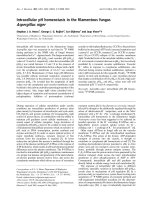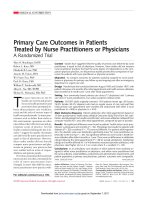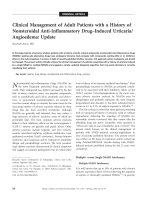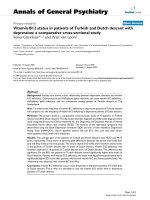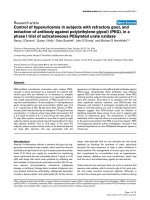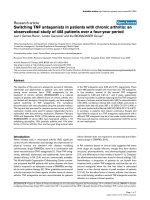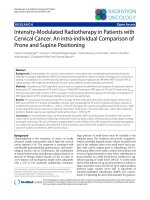Báo cáo y học: "Prophylactic open abdomen in patients with postoperative intra-abdominal hypertensio" pdf
Bạn đang xem bản rút gọn của tài liệu. Xem và tải ngay bản đầy đủ của tài liệu tại đây (115.89 KB, 2 trang )
A considerable number of patients with surgical emer-
gencies may develop visceral or retroperitoneal oedema
due to severe infl ammation, shock and fl uid resuscitation.
is oedema may prevent primary closure of the abdomen
or may lead to dangerously high intra-abdominal
pressure (IAP) and abdominal compartment syndrome
(ACS) if abdominal closure is attempted by force. As
reported in the previous issue of Critical Care, Matano
and colleagues [1] used the protocol for the open
abdomen based on intraoperative IAP measurement after
suturing of the fascia. e cutoff value of IAP for the open
abdomen was 12 mm Hg, which was considerably lower
than the recommended cutoff value of IAP (20 mm Hg)
for decompressive laparotomy because of ACS [2]. Using
this protocol, the authors showed overall low mortality
and high rate of delayed primary fascial closure using
either vacuum-assisted closure or the Bogota bag.
Although there is evidence that grade I or II (12 to
20mmHg) intra-abdominal hypertension (IAH) [2] can
disturb renal function [3], the maximal IAP level that
patients tolerate without risk of severe adverse eff ects at
the end of the primary operation or after subsequent
closure of the open abdomen needs to be defi ned. In this
context, the most relevant question is whether patients
with grade I or II IAH after the fascial closure benefi t
from prophylactic opening of the fascia or not.
Management of the open abdomen with temporary
abdominal closure (TAC) takes considerable health care
resources and predisposes the patient to the development
of complex ventral hernia [4] and intestinal fi stulas [5].
Delayed primary fascial closure cannot be achieved in a
considerable proportion of patients with the open
abdomen, and prolonged management of the open abdo-
men increases the risk for complications [6]. Factors that
aff ect delayed primary closure rate may involve TAC
technique, aetiology of the open abdomen, and the severity
of visceral oedema and factors aff ecting its resolu tion [6,7].
ere are few evidence-based data to support one TAC
technique over another. A recent systematic review [7]
suggested that vacuum-assisted closure and methods that
provide continuous fascial traction result in a higher
delayed primary fascial closure rate than other methods.
e fi rst randomized trial that compared vacuum-
assisted closure and polyglactin mesh-assisted closure
systems showed equal results in terms of delayed primary
fascial closure [8].
Abstract
Postoperative intra-abdominal hypertension (IAH) is a
frequent occurrence in critically ill patients operated
on for severe abdominal trauma, secondary peritonitis
or ruptured abdominal aortic aneurysm. IAH may
progress to abdominal compartment syndrome
(ACS) with new-onset organ dysfunction. Early
recognition of IAH and interventions that prevent
the development of ACS may preserve vital organ
functions and increase the probability of survival. The
best method to prevent postoperative ACS is to leave
the abdomen open during the operation. The decision
to leave the abdomen open is usually based on the
surgeon’s judgment without intra-abdominal pressure
(IAP) measurements during the operation. Because
signi cant morbidity and mortality are associated
with the open abdomen, the measurement of IAP
immediately after the fascial closure, when feasible,
could o er an objective method for determining the
optimal IAP threshold for leaving the abdomen open.
The management of the open abdomen requires a
temporary abdominal closure (TAC) system that would
ideally prevent the development of ACS and facilitate
later primary fascia closure. Among several TAC
systems, the most promising are those that provide
negative pressure to the wound or continuous fascial
traction or both.
© 2010 BioMed Central Ltd
Prophylactic open abdomen in patients with
postoperative intra-abdominal hypertension
Panu Mentula* and Ari Leppäniemi
See related research by Batacchi et al., />COMMENTARY
*Correspondence: panu.mentula@hus.
Department of Gastroenterological Surgery, Helsinki University Central Hospital, PL
340, 00029 HUS, Finland
Mentula and Leppäniemi Critical Care 2010, 14:111
/>© 2010 BioMed Central Ltd
As shown by Matano and colleagues [1], the vacuum-
assisted closure technique drains excess peritoneal fl uid
better than the Bogota bag, resulting in faster decrease of
IAP and thus facilitating earlier closure of the abdomen.
Another important component in the vacuum-assisted
closure technique is a polyurethane nonadherent layer
that covers the viscera and prevents the formation of
adhesions between the viscera and the peritoneum. is
may facilitate a better late closure rate [9] because these
adhesions are one of the main reasons why late fascial
closure fails in patients with the open abdomen [10]. In
cases with prolonged severe visceral swelling, the
vacuum-assisted closure system does not prevent lateral
retraction of the fascial edges. In such cases, the method
that combines vacuum-assisted closure and mesh-
mediated fascial traction has shown an excellent delayed
primary closure rate [11].
Mortality in patients with the open abdomen is high
but high mortality rates most probably refl ect the overall
severity of illness in these patients and are not related to
the open abdomen itself [12]. However, complications
that can occur in the course of open abdomen manage-
ment may be related to the TAC techniques and are likely
to cause some excess mortality [5]. Before more evidence-
based data are provided, the prophylactic use of the open
abdomen in surgical patients should be preserved for
those with high risk of ACS and death. Peroperative IAP
measurement after fascial closure may help to predict the
risk of ACS and may be useful in cases in which the clinical
decision for leaving the abdomen open is not easy.
In conclusion, Matano and colleagues [1] showed
clearly that the vacuum-assisted closure outperforms the
Bogota bag in the treatment of the open abdomen. e
results of the study are convincing and these should
encourage everyone to abandon the use of the Bogota
bag and switch to vacuum-assisted closure systems in
patients with the open abdomen. However, more studies
are needed to clarify indications for prophylactic open
abdomen in patients with postoperative IAH.
Abbreviations
ACS = abdominal compartment syndrome; IAH = intra-abdominal
hypertension; IAP = intra-abdominal pressure; TAC = temporary abdominal
closure.
Competing interests
The authors declare that they have no competing interests.
Published: 4 February 2010
References
1. Batacchi S, Matano S, Nella A, Zagli G, Bonizzoli M, Pasquini A, Anichini V,
Tucci V, Manca G, Ban K, Valeri A, Peris A: Vacuum-assisted closure device
enhances recovery of critically ill patients following emergency surgical
procedures. Crit Care,
13:
R194.
2. Cheatham M, Malbrain ML, Kirkpatrick A, Sugrue M, Parr M, De Waele J,
Balogh Z, Leppäniemi A, Olvera C, Ivatury R, D’Amours S, Wendon J, Hillman
K, Wilmer A: Results from the International Conference of Experts on Intra-
abdominal Hypertension and Abdominal Compartment Syndrome. II.
Recommendations. Intensive Care Med 2007, 33:951-962.
3. Dal no L, Tullo L, Donadio I, Malcangi V, Brienza N: Intra-abdominal
hypertension and acute renal failure in critically ill patients. Intensive Care
Med 2008, 34:707-713.
4. Jernigan TW, Fabian TC, Croce MA, Moore N, Pritchard FE, Minard G, Bee TK:
Staged management of giant abdominal wall defects: acute and long-
term results. Ann Surg 2003, 238:349-355; discussion 355-357.
5. Fischer PE, Fabian TC, Magnotti LJ, Schroeppel TJ, Bee TK, Maish GO, Savage
SA, Laing AE, Barker AB, Croce MA: A ten-year review of enterocutaneous
stulas after laparotomy for trauma. J Trauma 2009, 67:924-928.
6. Miller R, Morris J, Diaz J, Herring M, May A: Complications after 344 damage-
control open celiotomies. J Trauma 2005, 59:1365-1364.
7. Boele van Hensbroek P, Wind J, Dijkgraaf MGW, Busch ORC, Goslings JC:
Temporary closure of the open abdomen: a systematic review on delayed
primary fascial closure in patients with an open abdomen. World J Surg
2009, 33:199-207.
8. Bee TK, Croce MA, Magnotti LJ, Zarzaur BL, Maish GO, Minard G, Schroeppel
TJ, Fabian TC: Temporary abdominal closure techniques: a prospective
randomized trial comparing polyglactin 910 mesh and vacuum-assisted
closure. J Trauma 2008, 65:337-344.
9. Stevens P: Vacuum-assisted closure of laparostomy wounds: a critical
review of the literature. Int Wound J 2009, 6:259-266.
10. Björck M, Bruhin A, Cheatham M, Hinck D, Kaplan M, Manca G, Wild T, Windsor
A: Classi cation important step to improve management of patients with
an open abdomen. World J Surg 2009, 33:1154-1157.
11. Petersson U, Acosta S, Bjorck M: Vacuum-assisted wound closure and mesh-
mediated fascial traction – a novel technique for late closure of the open
abdomen. World J Surg 2007, 31:2133-2137.
12. De Waele JJ, Hoste EA, Malbrain ML: Decompressive laparotomy for
abdominal compartment syndrome a critical analysis. Crit Care 2006,
10:R51.
Mentula and Leppäniemi Critical Care 2010, 14:111
/>doi:10.1186/cc8207
Cite this article as: Mentula P, Leppäniemi A: Prophylactic open abdomen in
patients with postoperative intra-abdominal hypertension. Critical Care 2010,
14:111.
Page 2 of 2
